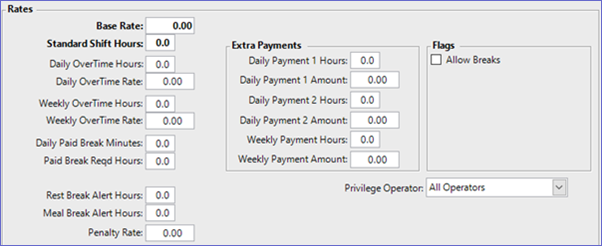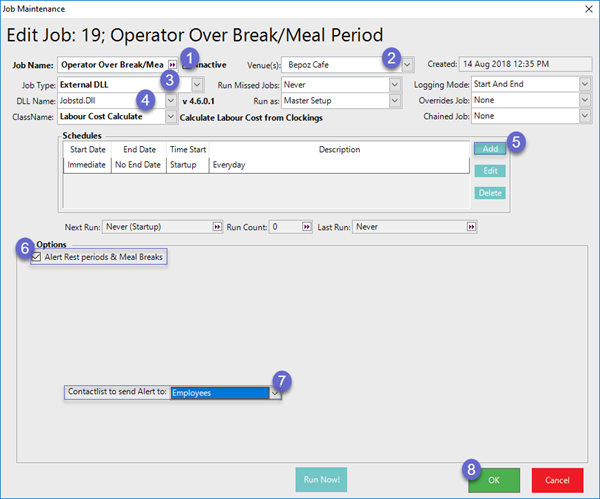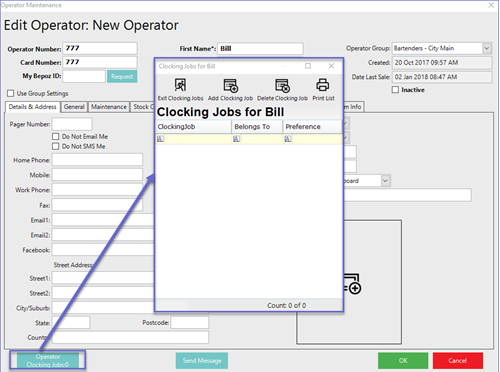- INTERNAL - Bepoz Help Guides
- End-User | Operators, Operator Permissions & Clocking
- Operator Clocking Module
-
End-User | Products & SmartPOS
-
End-User | Stock Control
-
End-User | Table Service and Kitchen Operations
-
End-User | Pricing, Marketing, Promotions & Accounts
- Prize Promotions
- Points, Points Profiles and Loyalty
- Product Promotions
- Repricing & Discounts in SmartPOS
- Vouchers
- Account Till Functions
- Pricing, Price Numbers and Price Modes
- Raffles & Draws
- Marketing Reports
- Accounts and Account Profiles
- Rewards
- SmartPOS Account Functions
- Troubleshooting
- Product Labels
- Packing Slips
-
End-User | System Setup & Admin
-
End-User | Reporting, Data Analysis & Security
-
End-User | Membership & Scheduled Billing
-
End-User | Operators, Operator Permissions & Clocking
-
Interfaces | Data Send Interfaces
-
Interfaces | EFTPOS & Payments
- NZ EFTPOS Interfaces
- Linkly (Formerly PC-EFTPOS)
- Adyen
- Tyro
- ANZ BladePay
- Stripe
- Windcave (Formerly Payment Express)
- Albert EFTPOS
- Westpac Presto (Formerly Assembly Payments)
- Unicard
- Manager Cards External Payment
- Pocket Voucher
- OneTab
- Clipp
- eConnect-eConduit
- Verifone
- AXEPT
- DPS
- Liven
- Singapore eWallet
- Mercury Payments TRANSENTRY
- Ingenico
- Quest
- Oolio - wPay
-
Interfaces | SMS & Messaging
-
Interfaces | Product, Pricing, Marketing & Promotions
- Metcash Loyalty
- Range Servant
- ILG Pricebook & Promotions
- Oolio Order Manager Integration
- Ubiquiti
- Product Level Blocking
- BidFood Integration
- LMG
- Metcash/IBA E-Commerce Marketplace
- McWilliams
- Thirsty Camel Hump Club
- LMG Loyalty (Zen Global)
- Doshii Integration
- Impact Data
- Marsello
- IBA Data Import
- Materials Control
- Last Yard
- Bepoz Standard Transaction Import
-
Interfaces | Printing & KDS
-
Interfaces | Reservation & Bookings
-
Interfaces | Database, Reporting, ERP & BI
-
Interfaces | CALink, Accounts & Gaming
- EBET Interface
- Clubs Online Interface
- Konami Interface
- WIN Gaming Interface
- Aristocrat Interface
- Bally Interface
- WorldSmart's SmartRetail Loyalty
- Flexinet & Flexinet SP Interfaces
- Aura Interface
- MiClub Interface
- Max Gaming Interface
- Utopia Gaming Interface
- Compass Interface
- IGT & IGT Casino Interface
- MGT Gaming Interface
- System Express
- Aristocrat nConnect Interface
- GCS Interface
- Maxetag Interface
- Dacom 5000E Interface
- InnTouch Interface
- Generic & Misc. CALink
-
Interfaces | Miscellaneous Interfaces/Integrations
-
Interfaces | Property & Room Management
-
Interfaces | Online Ordering & Delivery
-
Interfaces | Purchasing, Accounting & Supplier Comms
-
SmartPOS | Mobile App
-
SmartPDE | SmartPDE 32
-
SmartPDE | Denso PDE
-
SmartPDE | SmartPDE Mobile App
-
MyPlace
-
MyPlace | myPLACE Lite
-
MyPlace | Backpanel User Guides
- Bepoz Price Promotions
- What's on, Events and tickets
- Staff
- System Settings | Operational Settings
- Vouchers & Gift Certificates
- Member Onboarding
- Members and memberships
- System Settings | System Setup
- Reports and Reporting
- Actions
- Offers | Promotions
- Messaging & Notifications
- System Settings | App Config
- Surveys
- Games
- User Feedback
- Stamp Cards
-
MyPlace | Integrations
-
MyPlace | FAQ's & How-2's
-
MyPlace | Release Notes
-
YourOrder
-
YourOrders | Backpanel User Guides
-
YourOrders | YourOrder Kiosk User Guide
-
YourOrders | Merchant App User Guide
-
WebAddons
-
Installation / System Setup Guides
- SmartPOS Mobile App | Setup
- SmartPOS Mobile App | SmartAPI Host Setup
- SmartPOS Mobile App | BackOffice Setup
- SmartPOS Mobile App | Pay@Table setup
- SmartKDS Setup 4.7.2.7 +
- SmartKDS Setup 4.6.x
- SQL Installations
- Server / BackOffice Installation
- New Database Creation
- Multivenue Setup & Config.
- SmartPOS
- SmartPDE
- Player Elite Interface | Rest API
- Interface Setups
- Import
- KDSLink
- Snapshots
- Custom Interface Setups
-
HOW-2
- Product Maintenance
- Sales and Transaction Reporting
- SmartPOS General
- Printing and Printing Profiles
- SQL
- Repricing & Discounts
- Stock Control
- Membership
- Accounts and Account Profiles
- Miscellaneous
- Scheduled Jobs Setups
- Backoffice General
- Purchasing and Receiving
- Database.exe
- EFTPOS
- System Setup
- Custom Support Tools
-
Troubleshooting
-
Hardware
3 | Clocking Job Configurations
After accessing Clocking Setup via the Operational Setup menu, various Clocking Jobs can be maintained. Use the buttons in the header section of the Clocking Jobs tab to Add, Edit, and Delete Clocking Jobs. This article will cover Clocking Job maintenance and the fields settings within a Clocking Job Setup. This article also covers Operator Clockings so that if an Operator has multiple Clocking Jobs assigned to them, they will have the ability to select the appropriate Clocking Job when they Clock In for a shift.
After accessing Clocking Setup via the Operational Setup menu, various Clocking Jobs can be maintained. Use the buttons in the header section of the Clocking Jobs tab to Add, Edit, and Delete Clocking Jobs.
This article will cover Clocking Job maintenance and the fields & settings within a Clocking Job Setup. This article also covers Operator Clockings so that if an Operator has multiple Clocking Jobs assigned to them, they will have the ability to select the appropriate Clocking Job when they Clock In for a shift.
Prerequisites
- For more information on Clocking Prerequisites, please refer to the
Clocking Job Prerequisites Article
Clocking Job Maintenance
- Whether Adding a new Clocking Job or Editing an existing Clocking Job, the Clocking Job Maintenance window will remain the same; the fields and settings will be outlined below
Header
- On the top of the window, there are 3 fields as shown below

- Name – Name of the Clocking Job
- Allowed Venues – This allows for selecting a Venue, Venue Group, or Venue Set if the Clocking Job should not be available in All Venues (only used for Multi-Venue Organizations)
- Description – This is an optional text field for setting a description for the Clocking Job
Rates
- Below are fields for the Rates setup
- These fields allow customizing the rates for overtime, meal rates, paid breaks and rest breaks

Mandatory Fields
- There are two fields required for Clocking setup
- Base rate – This is the base Labor Cost rate for the type of Clocking Job
- Standard Shift hours – This is the standard length of a single shift in hours
Overtime Fields
- Daily Overtime hours – Set the Daily overtime hours, if more then the daily hours are worked in a day
- Daily Overtime Rate – Set the rate for the daily overtime hours that will be paid. daily overtime rate will be used for excessive hours
- Weekly Overtime hours – If more than the weekly overtime hours are worked in a week, then the weekly overtime rate will be used for the excessive hours
- Weekly Overtime Rate – Set the rate for weekly overtime hours that will be paid. If both daily and weekly overtime hours are passed then the highest rate will be used
Paid Breaks
- Daily Paid Breaks Minutes - Sets on how long an operator gets a paid break
- Paid Break Reqd Hours – Minimum number of working hours required to take a break
Breaks Alert Fields
- Rest break alert hours – Set the hours to be alerted for a rest break
- Meal break alert hours - Set the hours to be alerted for a meal break
Alerts for Exceeded Meal Breaks
- With Bepoz, a
Scheduled Job can be created to Alert when Break Periods are exceeded - To do so, go to System Setup > Scheduled Job
- Click on the Add Job button
- Type the Name and Select Venue for the Job
- The DLL Name for this Job should be "Jobstd.DII" and ClassName should be "Labour Cost Calculate"
- Select a Schedule for the Alert by Clicking the Add button on the Schedule section
- Tick the Flag "Alert Rest Periods & Meal Breaks" On and Select the "Contact list to send Alert to" from the drop-down menu

Penalty Fields
- Penalty rate – This field allows setting the penalty rate if the venue has certain times that pays different to the shift Base Rate
- Penalty rate Schedule – This is a list of schedules for the Clocking Job's Penalty Rate

Extra payments
- Extra Payments are used for working an amount of time, meal allowance etc.
- E.g., work more than 4 hours you get $15 Payment for a meal
- Daily payments – Daily payment Hours are worked in one day. Then the Daily Payment Amount will be paid to the operator labor cost
- Weekly Payments - Weekly payment Hours are worked in a week. Then the Weekly Payment Amount will be paid to the operator labor cost
Flags
- Allowed Breaks – This flag allows for rest and meal breaks controlled by the Operator from the Till

Privilege Operator
- Privilege Operator controls an Operator's privileges on the basis of Job they have clocked in for
- Appropriate privilege level can be chosen by using the drop-down and selecting an Operator or Operator Group from the System who's privileges will be passed on to an Operator who Clocks In using this Job

Assigning a Clocking Job to an Operator
- To Assign a Clocking Job to an Operator, Go to Maintainance > Operator Maintainance
- Double-click the Operator who needs Clocking Jobs or highlight the Operator and click on Edit Operator
- Click on the Operator Clocking Jobs Icon on the bottom of the window which will open a Clocking Job window

- Clocking Jobs can be Added and Deleted from this window
- With Bepoz, Operators can also edit the assigned Clocking Job by double-clicking the Clocking Job that has been assigned
Related Material
-
Clocking Job Prerequisites -
Clocking Job Functionalities -
Clocking Reports
